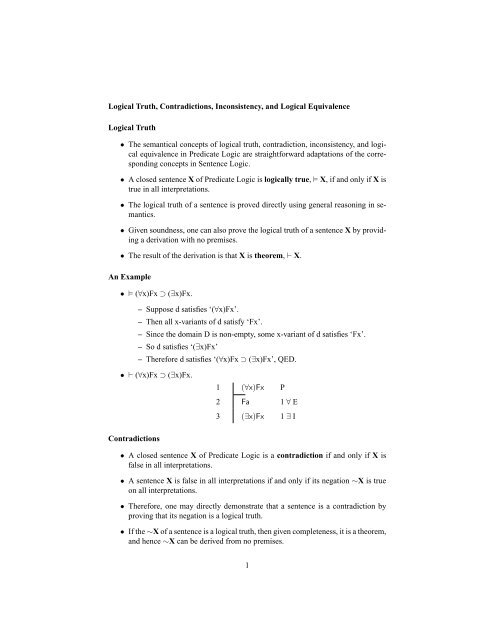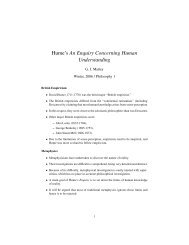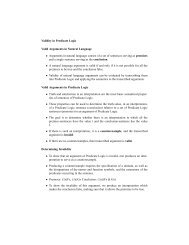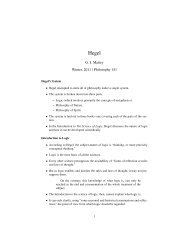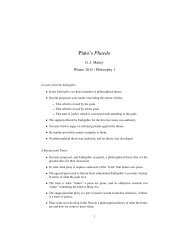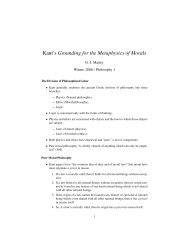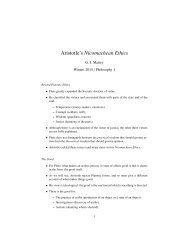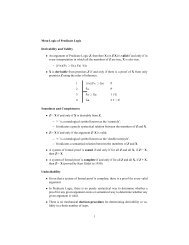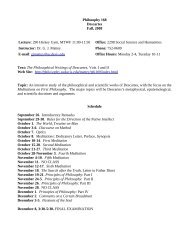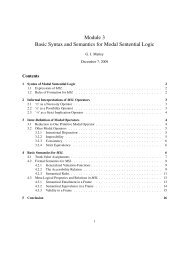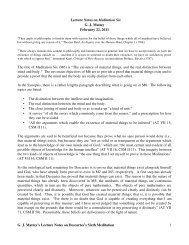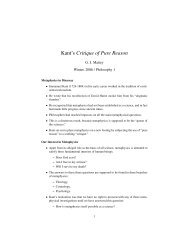Metalogical Properties in Predicate Logic - the UC Davis Philosophy ...
Metalogical Properties in Predicate Logic - the UC Davis Philosophy ...
Metalogical Properties in Predicate Logic - the UC Davis Philosophy ...
You also want an ePaper? Increase the reach of your titles
YUMPU automatically turns print PDFs into web optimized ePapers that Google loves.
<strong>Logic</strong>al Truth, Contradictions, Inconsistency, and <strong>Logic</strong>al Equivalence<strong>Logic</strong>al Truth• The semantical concepts of logical truth, contradiction, <strong>in</strong>consistency, and logicalequivalence <strong>in</strong> <strong>Predicate</strong> <strong>Logic</strong> are straightforward adaptations of <strong>the</strong> correspond<strong>in</strong>gconcepts <strong>in</strong> Sentence <strong>Logic</strong>.• A closed sentence X of <strong>Predicate</strong> <strong>Logic</strong> is logically true, X, if and only if X istrue <strong>in</strong> all <strong>in</strong>terpretations.• The logical truth of a sentence is proved directly us<strong>in</strong>g general reason<strong>in</strong>g <strong>in</strong> semantics.• Given soundness, one can also prove <strong>the</strong> logical truth of a sentence X by provid<strong>in</strong>ga derivation with no premises.• The result of <strong>the</strong> derivation is that X is <strong>the</strong>orem, ⊢ X.An Example• (∀x)Fx ⊃ (∃x)Fx.– Suppose d satisfies ‘(∀x)Fx’.– Then all x-variants of d satisfy ‘Fx’.– S<strong>in</strong>ce <strong>the</strong> doma<strong>in</strong> D is non-empty, some x-variant of d satisfies ‘Fx’.– So d satisfies ‘(∃x)Fx’– Therefore d satisfies ‘(∀x)Fx ⊃ (∃x)Fx’, QED.• ⊢ (∀x)Fx ⊃ (∃x)Fx.1 (∀x)Fx P2 Fa 1 ∀ E3 (∃x)Fx 1 ∃ IContradictions• A closed sentence X of <strong>Predicate</strong> <strong>Logic</strong> is a contradiction if and only if X isfalse <strong>in</strong> all <strong>in</strong>terpretations.• A sentence X is false <strong>in</strong> all <strong>in</strong>terpretations if and only if its negation ∼X is trueon all <strong>in</strong>terpretations.• Therefore, one may directly demonstrate that a sentence is a contradiction byprov<strong>in</strong>g that its negation is a logical truth.• If <strong>the</strong> ∼X of a sentence is a logical truth, <strong>the</strong>n given completeness, it is a <strong>the</strong>orem,and hence ∼X can be derived from no premises.1
• If a sentence X is such that if it is true <strong>in</strong> any <strong>in</strong>terpretation, both Y and ∼Y aretrue <strong>in</strong> that <strong>in</strong>terpretation, <strong>the</strong>n X cannot be true on any <strong>in</strong>terpretation.• Given soundness, it follows that if Y and ∼Y are derivable from X, <strong>the</strong>n X is acontradiction.An Example• ‘(∀x)(Fx & ∼Fx)’ is a contradiction.– Suppose that a variable assignment d satisfies ‘(∀x)(Fx & ∼Fx)’.– Then all x-variants d[u/x] of d satisfy ‘Fx & ∼Fx’.– Then d[u/x] satisfies ‘Fx’.– Then d[u/x] satisfies ‘∼Fx’.– Then d[u/x] does not satisfy ‘Fx’, a contradiction.– Therefore, no variable assigment d satisfies ‘(∀x)(Fx & ∼Fx)’, QED.Inconsistent Sets of Sentences1 (∀x)(Fx& ∼ Fx) P2 Fa& ∼ Fa 1 ∀ E3 Fa 2 & E4 ∼ Fa 2 & E• A set of closed sentences of <strong>Predicate</strong> <strong>Logic</strong> is consistent if and only if <strong>the</strong>re isan <strong>in</strong>terpretation (a model) which makes all <strong>the</strong> sentences <strong>in</strong> <strong>the</strong> set true.• A set of closed sentences of <strong>Predicate</strong> <strong>Logic</strong> is <strong>in</strong>consistent just <strong>in</strong> case it is notconsistent.• Therefore, a set of closed sentences of <strong>Predicate</strong> <strong>Logic</strong> is <strong>in</strong>consistent just <strong>in</strong> caseit has no models.• It follows from <strong>the</strong>se def<strong>in</strong>itions and that of a contradiction that a f<strong>in</strong>ite collectionof sentences is <strong>in</strong>consistent if and only if <strong>the</strong> conjunction of <strong>the</strong> sentences is acontradiction.– There is no model for a set of sentences X if and only if <strong>in</strong> every <strong>in</strong>terpretation,each of <strong>the</strong> sentences of X is false.– This holds if and only if <strong>in</strong> every <strong>in</strong>terpretation, <strong>the</strong> conjunction of <strong>the</strong>sentences of X is false.– This holds if and only if <strong>the</strong> conjunction of <strong>the</strong> sentences of X is a contradiction,QED.2
Demonstrat<strong>in</strong>g Inconsistency• The consistency of a set of closed sentences can be demonstrated by provid<strong>in</strong>g as<strong>in</strong>gle <strong>in</strong>terpretation which makes all <strong>the</strong> sentences <strong>in</strong> <strong>the</strong> set true.• A direct demonstration of <strong>in</strong>consistency requires general reason<strong>in</strong>g.• Inconsistency can be proved <strong>in</strong>directly be ei<strong>the</strong>r of two ways.An Example– Derive a contradiction from <strong>the</strong> set of <strong>in</strong>consistent sentences taken as premises.– Derive <strong>the</strong> negation of <strong>the</strong> conjunction of <strong>the</strong> sentences from no premises.• {‘(∀x)Fx’, ‘∼(∃x)Fx’} is <strong>in</strong>consistent.– Suppose <strong>the</strong>re is an <strong>in</strong>terpretation which makes both ‘(∀x)Fx’ and ‘∼(∃x)Fx’true.– Then for a given variable assignment d, d satisfies both ‘(∀x)Fx’ and ‘∼(∃x)Fx’.– Therefore, all x-variants d[u/x] of d satisfy ‘Fx’.– So d satisfies ‘(∃x)Fx’.– It also follows that d satisfies ‘∼(∃x)Fx’, which yields a contradiction.– So, <strong>the</strong>re is no <strong>in</strong>terpretation which makes both ‘(∀x)Fx’, ‘∼(∃x)Fx’ true,QED.The Example Cont<strong>in</strong>ued<strong>Logic</strong>al Equivalence1 (∀x)Fx& ∼ (∃x)Fx P2 (∀x)Fx 1 & E3 Fa 2 ∀ E4 (∃x)Fa 3 ∃ I5 ∼ (∃x)Fx 1 & E• Two closed sentences of <strong>Predicate</strong> <strong>Logic</strong> are logically equivalent if and only if<strong>the</strong>y have <strong>the</strong> same truth value <strong>in</strong> all <strong>in</strong>terpretations.• The logical equivalence of X and Y holds as well when X is true <strong>in</strong> all <strong>in</strong>terpretationswhere Y is true, and Y is true <strong>in</strong> all <strong>in</strong>terpretations where X is true.• Alternatively, two sentences X and Y are logically equivalent just <strong>in</strong> case <strong>the</strong>irbicondition X ≡ Y is a logical truth.3
• <strong>Logic</strong>al equivalence is demonstrated directly through general reason<strong>in</strong>g.• It is proved <strong>in</strong>directly with two derivations, each hav<strong>in</strong>g one of <strong>the</strong> sentences asa premise and <strong>the</strong> o<strong>the</strong>r as a conclusion.4


